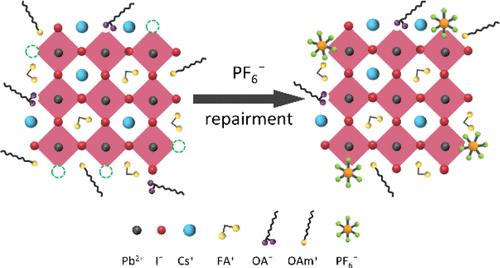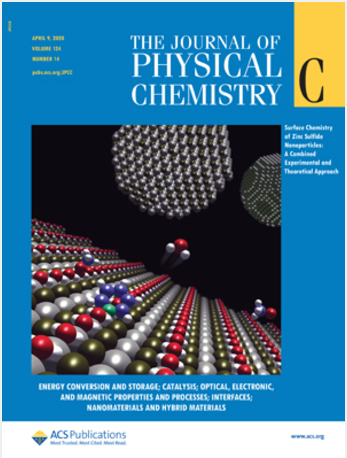用于混合阳离子包晶石纳米晶体的伪卤化物阴离子表面工程
IF 3.2
3区 化学
Q2 CHEMISTRY, PHYSICAL
引用次数: 0
摘要
卤化铅包晶石纳米晶体(NCs)在光电领域取得了长足的发展。混合阳离子包晶 Cs1-xFAxPbI3 NCs 因其结构稳定性更好、光吸收范围更广而在光电器件中展现出巨大潜力。然而,实现具有较少表面缺陷的均质 Cs1-xFAxPbI3 NCs 仍然具有挑战性。在这项工作中,我们采用了两步交换钝化法制备 Cs1-xFAxPbI3 NCs,并采用了基于伪卤化离子的表面修复策略来降低表面陷阱密度。由于伪卤化离子的半径与碘离子的半径相似,且与 F 原子的电负性较强,伪卤化离子可以填补 NC 表面的碘空位,并与 FA+ 形成氢键,从而改善光电性能,抑制载流子的非再结合。这项工作凸显了表面化学在包晶 NC 中的重要性,并可能为合成高性能混合 A 位包晶 NC 在未来的应用提供启示。本文章由计算机程序翻译,如有差异,请以英文原文为准。

Pseudohalide Anion Surface Engineering for Mixed Cation Perovskite Nanocrystals
Lead halide perovskite nanocrystals (NCs) have undergone great development in the optoelectrical field. The mixed cation perovskite Cs1–xFAxPbI3 NCs exhibit great potential in photoelectric devices because of their improved structural stability and increased light absorption range. However, achieving homogeneous Cs1–xFAxPbI3 NCs with fewer surface defects remains challenging. In this work, we employ a two-step exchange-passivation method for the preparation of Cs1–xFAxPbI3 NCs and adopt a surface repair strategy based on pseudohalide ions to decrease the surface trap density. Owing to the similar radius of the pseudohalide ions to that of the iodine ions and their strong electronegativity from F atoms, the pseudohalide ions can fill the surface iodine vacancies of the NCs and form Hydron bonds with FA+, resulting in improved photoelectric properties and suppressed nonrecombination of carriers. This work highlights the importance of surface chemistry in perovskite NCs and may provide insights for synthesizing high-performance mixed A-site perovskite NCs for future applications.
求助全文
通过发布文献求助,成功后即可免费获取论文全文。
去求助
来源期刊

The Journal of Physical Chemistry C
化学-材料科学:综合
CiteScore
6.50
自引率
8.10%
发文量
2047
审稿时长
1.8 months
期刊介绍:
The Journal of Physical Chemistry A/B/C is devoted to reporting new and original experimental and theoretical basic research of interest to physical chemists, biophysical chemists, and chemical physicists.
 求助内容:
求助内容: 应助结果提醒方式:
应助结果提醒方式:


